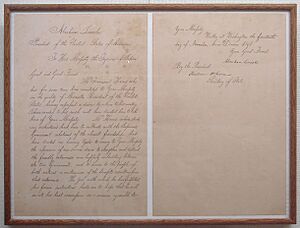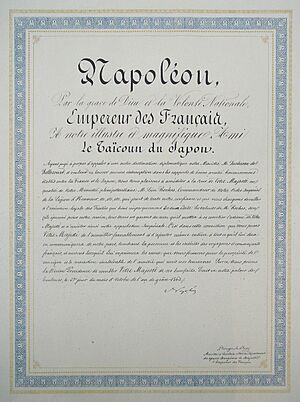Tokugawa Iemochi facts for kids
Quick facts for kids
Tokugawa Iemochi
|
|
|---|---|
 |
|
| Shōgun | |
| In office August 14, 1858 – August 29, 1866 |
|
| Monarch | Kōmei |
| Preceded by | Tokugawa Iesada |
| Succeeded by | Tokugawa Yoshinobu |
| Personal details | |
| Born | July 17, 1846 Minato, Edo, Japan |
| Died | August 29, 1866 (aged 20) Osaka Castle, Japan |
| Spouse | Princess Kazu |
| Signature |  |
Tokugawa Iemochi (徳川 家茂) (July 17, 1846 – August 29, 1866) was the 14th shōgun of Japan. A shōgun was like a military ruler who led the country. Iemochi was part of the Tokugawa shogunate, a government that ruled Japan for over 250 years.
He was shōgun from 1858 to 1866. During his time, Japan was going through big changes. It was "re-opening" to Western countries after being mostly closed off. This caused a lot of trouble and made the shogunate weaker. Iemochi died in 1866 and was buried at Zōjō-ji temple.
Contents
Early Life and Becoming Shōgun
Iemochi was born in 1846 in Edo (which is now Tokyo). His childhood name was Kikuchiyo. He was the oldest son of Tokugawa Nariyuki, a powerful lord from the Wakayama area. Nariyuki was also the son of the 11th shōgun, Tokugawa Ienari.
Adoption and Succession
When he was just one year old in 1847, Iemochi was adopted by another lord, Tokugawa Narikatsu. He took over Narikatsu's position in 1850. After he grew up in 1851, he changed his name to Tokugawa Yoshitomi.
In 1858, he met the 13th shōgun, Tokugawa Iesada, and his wife, Atsuhime. Soon after, Iemochi was adopted as their son and chosen to be the next head of the Tokugawa family. This choice was debated because other people wanted to be shōgun. They supported adults like Tokugawa Yoshinobu or Matsudaira Naritami. But Yoshitomi was chosen. When he became shōgun, he changed his name to Iemochi.
Instructions for the Young Shōgun
Before Shōgun Iesada died, he gave important instructions to his chief minister, Ii Naosuke. These instructions were to help Iemochi rule:
- Ii Naosuke was to help Iemochi with running the government until Iemochi was old enough to do it himself.
- All important political issues had to be discussed with Tenshoin, who was like Iemochi's mother.
Important Events During His Rule
Iemochi's time as shōgun was very busy and challenging. Japan was facing pressure from other countries.
Marriage to Princess Kazu
In 1862, Iemochi married Princess Kazu. She was the daughter of Emperor Ninko. This marriage was part of a plan called kōbu gattai, which means "Union of Court and Bakufu." It was an effort to bring the Emperor's court and the shōgun's government closer together. Princess Kazu did not use the usual title for a shōgun's wife. She preferred to use her royal title, "Miya."
Journey to Kyoto
On April 22, 1863, Shōgun Iemochi made a grand trip to Kyoto, the Emperor's capital. He had been called by the Emperor and traveled with about 3,000 escorts. This was a very rare event. The last time a shōgun had visited Kyoto was 230 years before, when Tokugawa Iemitsu visited.


Later Life and Legacy
Iemochi died young, at the age of 20. His marriage to Princess Kazu-no-Miya was short. Before he died, he adopted a son named Tayasu Kamenosuke. This boy later became Tokugawa Iesato.
Succession and the End of an Era
At the time of Iemochi's death, Japan was fighting a war with the Chōshū domain. Because Tayasu Kamenosuke was only three years old, an adult, Tokugawa Yoshinobu, was chosen to be the 15th shōgun. Shōgun Yoshinobu then adopted Iemochi's adopted son, Tayasu Kamenosuke. After Iemochi passed away, Kazu-no-Miya changed her name to Seikan'in no Miya.
It is believed that Iemochi died from heart failure caused by beriberi. This disease happens when someone doesn't get enough thiamine (vitamin B1).
His successor, Tokugawa Yoshinobu, was the last Tokugawa shōgun. He saw the end of the shogunate and the beginning of the Meiji Restoration. This was a time when the Emperor regained power, and Japan began to modernize rapidly.
Family Life
- Father: Tokugawa Nariyuki (1801–1846)
- Mother: Jitsujoin (1821–1904)
- Adoptive Fathers:
- Tokugawa Narikatsu (1820–1849)
- Tokugawa Iesada
- Adoptive Mother: Tenshō-in
- Wife: Kazu-no-Miya Chikako
- Adopted Sons:
- Tokugawa Mochitsugu
- Tokugawa Iesato
Eras During Iemochi's Rule
In Japan, years are also named after different eras, called nengō. Here are the eras when Iemochi was shōgun:
See also
 In Spanish: Tokugawa Iemochi para niños
In Spanish: Tokugawa Iemochi para niños

